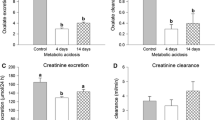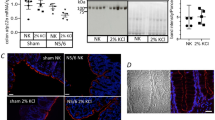Abstract
Enteric secretion of oxalate is induced in rats that have chronic renal failure produced by 5/6 nephrectomy [2]. The purpose of the present study was to examine renal and intestinal handling of oxalate in rats with chronic renal failure (CRF) induced by chronic hyperoxaluria. A rat model for chronic renal failure, induced by chronic hyperoxaluria (CH-CRF), was produced by unilateral nephrectomy combined with dietary ethylene glycol for 4 weeks. Both intact and unilateral nephrectomized rats (UN) without the oxalate load served as controls. Renal handling of oxalate was assessed by measurement of renal clearance of oxalate and creatinine while colonic handling of oxalate and chloride was determined by in vitro transepithelial flux measurements. Angiotensin II mediation was assessed by sensitivity of the transport processes to the AT1 receptor antagonist losartan. Renal and colonic handling of oxalate in UN rats were similar to intact controls. The CH-CRF rats were hyperoxalemic, hyperoxaluric, and exhibited a twofold increase in oxalate clearance despite a 50% drop in creatinine clearance. Distal (but not proximal) colonic handling of oxalate in CH-CRF rats was reversed from net oxalate absorption seen in UN and intact controls to net secretion that was sensitive to losartan in vitro. Conclusion: Although enteric oxalate secretion can be correlated with elevations in plasma oxalate in the absence of overt renal insufficiency by an ANG II-independent mechanism, the present results suggest that some degree of renal insufficiency is necessary to induce ANG II-mediated colonic oxalate secretion.




Similar content being viewed by others
References
Costello JF, Smith M, Stolarski C, Sadovnic MJ (1992) Extrarenal clearance of oxalate increases with progression of renal failure in the rat. J Am Soc Nephrol 3:1098
Hatch M, Freel RW, Vaziri ND (1994) Intestinal excretion of oxalate in chronic renal failure. J Am Soc Nephrol 5:1339
Hatch M, Freel RW, Vaziri ND (1999) Regulatory aspects of oxalate secretion in enteric oxalate elimination. J Am Soc Nephrol 10:S324
Hatch M (1990) Spectrophotometric determination of oxalate in whole blood. Clin Chim Acta 193:199
Hatch M, Freel RW, Shahinfar S, Vaziri ND (1996) Effects of the specific angiotensin II receptor antagonist losartan on urate homeostasis and intestinal urate transport. J Pharmacol Exp Ther 276:187
Hatch M, Freel RW (2002) Renal and intestinal handling of oxalate following oxalate loading in rats. Am J Nephrol 23:18
Hatch M, Freel RW, Vaziri ND (1998) Losartan antagonism of angiotensin-II-induced potassium secretion across rat colon. Pflugers Arch 436:717
Hatch M, Freel RW, Vaziri ND (1999) AT1 receptor up-regulation in intestine in chronic renal failure is segment specific. Pflugers Arch 437:881
Hoppe B, Kemper MJ, Bokenkamp A, Portale AA, Cohn RA, Langman CB (1999) Plasma calcium oxalate supersaturation in children with primary hyperoxaluria and end-stage renal failure. Kidney Int 56:268
Kasidas GP (1988) In: Rose GA (ed) Oxalate metabolism in relation to urinary stone. Springer, Berlin Heidelberg New York, pp 45–64
Mansell MA, Watts RWE (1988) In: Rose GA (ed) Oxalate metabolism in relation to urinary stone. Springer-Verlag, London, p 167
Greger R, Lang H, Oberleithner H, Deetjen P (1978) Handling of oxalate by the rat kidney. Pflugers Arch 374:243
Weinman EJ, Frankfurt SJ, Ince A, Sansom S (1978) Renal tubular transport of organic acids. J Clin Invest 61:801
Knight TF, Sansom S, Senekjian HO, Weinman EJ (1981) Oxalate secretion in rat proximal tubule. Am J Physiol 240:F295
Hatch M, Freel RW, Vaziri ND (1994) Mechanisms of oxalate absorption and secretion across the rabbit distal colon. Pflugers Arch 426:101
Hatch M, Freel RW, Vaziri ND (1993) Characteristics of the transport of oxalate and other ions across rabbit proximal colon. Pflugers Arch 423:206
Hatch M, Freel RW, Goldner AM, Earnest DL (1984) Oxalate and chloride absorption by the rabbit colon: sensitivity to metabolic and anion transport inhibitors. Gut 25:232
Freel RW, Hatch M, Vaziri ND (1998) Conductive pathways for chloride and oxalate in rabbit ileal brush-border membrane vesicles. Am J Physiol 275:C748
Hatch M, Freel RW (1995) Alterations in intestinal transport of oxalate in disease states. Scanning Microsc 9:1121
Barrett KE, Keely SJ (2000) Chloride secretion by the intestinal epithelium: molecular basis and regulatory aspects. Annu Rev Physiol 62:535
Frizzell RA, Morris AP (1994) Chloride conductances of salt-secreting epithelial cells. Curr Top Memb 42:C148
Acknowledgements
This work was supported in part by a grant from the Oxalosis and Hyperoxaluria Foundation and in part by NIH (R01 DK56245).
Author information
Authors and Affiliations
Corresponding author
Rights and permissions
About this article
Cite this article
Hatch, M., Freel, R.W. Angiotensin II involvement in adaptive enteric oxalate excretion in rats with chronic renal failure induced by hyperoxaluria. Urol Res 31, 426–432 (2003). https://doi.org/10.1007/s00240-003-0367-5
Received:
Accepted:
Published:
Issue Date:
DOI: https://doi.org/10.1007/s00240-003-0367-5




